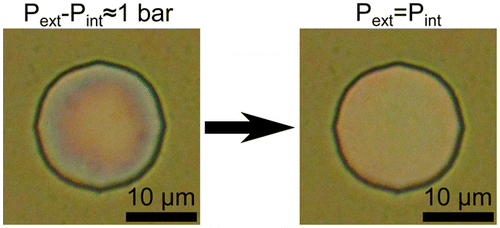more »
Graphene membranes hold potential for many applications, for example gas impermeable membranes, MEMS and NEMS pressure sensors, water filtration, high sensitivity ultrasonic speakers and microphones, quantum memories, and for fundamental scientific studies of opto- and nano-mechanics. Reliable large-scale characterization of graphene membranes has been elusive, because all known techniques actually affect the membrane during measurement, while also demanding costly equipment that does not allow parallel measurement of several membranes, hindering commercialization of graphene mechanical sensors.
A new method, developed at the Kavli Institute of Nanoscience at Delft University in the Netherlands, uses simple optical interference measured under a modified microscope to resolve the deflection of graphene membranes. The deflection is measured by looking at the optical interference between the light reflected off the drum and a silicon substrate. A simple fitting algorithm is applied to extract the exact deflection at the center of the drum.
The novel method is used to study diffusion of air through double-layer graphene membranes. Defect-free single layer graphene (SLG) would make a completely impermeable gas membrane if it were perfect, however in real conditions any SLG has a significant amount of cracks and wrinkles, enough to quickly let trapped gases seep out. However, if two independently grown sheets of graphene are stacked on each other, then for the most part the defects of the two sheets do not overlap, yielding a much less permeable membrane.
Using Graphenea’s technique of making suspended graphene on cavities, the research team created a matrix of double-layer graphene (DLG) membranes. DLG, apart from providing better gas membranes, has a higher optical contrast than SLG, making the experiments easier. The scientists studied membrane deflection while filling and purging the microcavities with air. A little surprisingly, they found that the membranes have higher permeance for purging than they have for filling with air. The results indicate that there are more purging channels than filling ones, perhaps related to the graphene-substrate interface.
The latest results, published in the journal Nano Letters under the title “Colorimetry Technique for Scalable Characterization of Suspended Graphene”, provide insight into the mechanics of graphene membranes, especially in relation to gas permeation applications. At the same time, the paper discusses a new method of characterization that should prove to be useful for studying graphene membranes as they progress from the lab to the marketplace.

Figure: Graphene drum deflection under pressure (reprinted with permission from Nano Letters, DOI: 10.1021/acs.nanolett.6b02416. Copyright 2016 American Chemical Society).
About Graphenea
Graphenea, a leading graphene producer venture backed by Repsol, was established in 2010, and has since grown to be one of the world's largest providers of graphene. The company is headquartered at the nanotechnology cluster CIC nanoGune in San Sebastian, Spain and the MIT campus in Cambridge, MA Boston. Graphenea employs 22 people and exports graphene materials to more than 600 customers in 55 countries. The company has focused on constant improvement of graphene quality, becoming a supplier customers can rely on. Graphenea employs a team of skilled laboratory staff who have brought graphene production techniques to a new level. Graphenea produces CVD graphene wafers and graphene oxide. Graphenea partners with large multinationals to develop custom graphene materials for their applications. Its research agility and ability to keep pace with the progress of graphene science and technology has allowed Graphenea to become a core partner in the Graphene Flagship, a ten year project of the European Commission worth a billion euros. The company keeps a close relation with the world's leading scientists, regularly publishing scientific articles of the highest level and holds a strong patent portfolio.
via Graphenea
